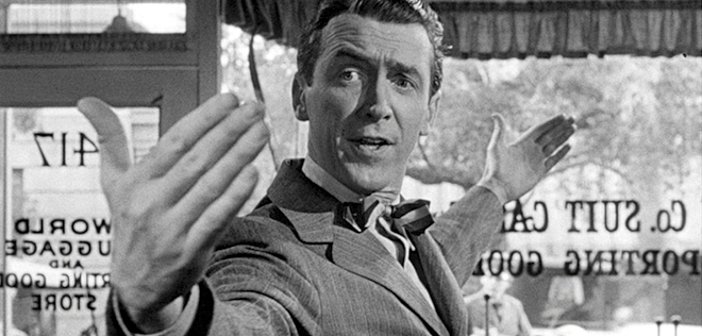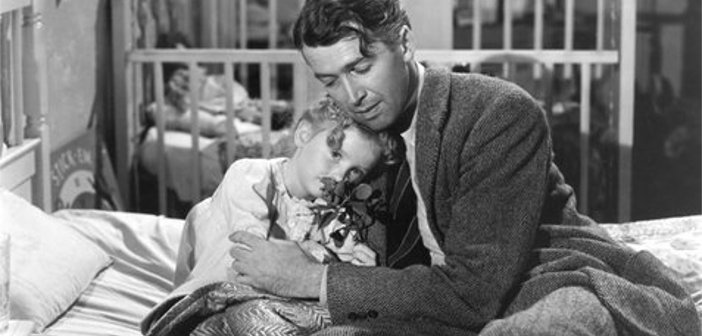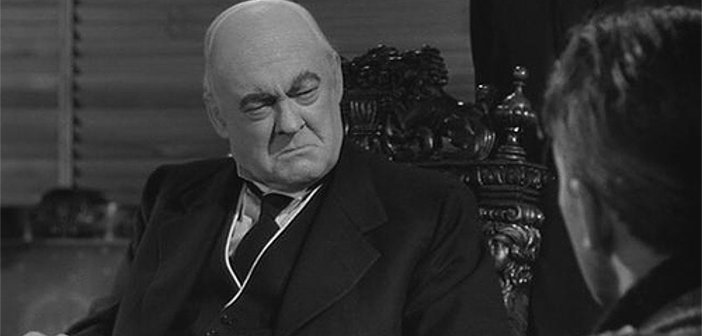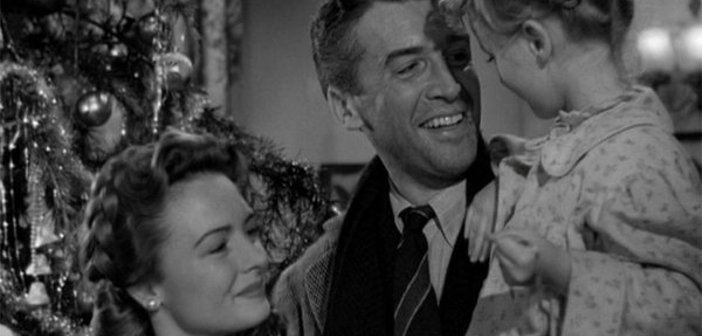Film Feature | What Makes It’s a Wonderful Life a Much-Loved Christmas Classic?
Frank Capra’s It’s a Wonderful Life, the now perennial festive favourite, was a flop when first released in 1946 and would not have left even so much as a dent in the history of popular cinema had it not been for, strangely enough, audiences forgetting completely about its very existence. It may seem strange to say but audience’s collective amnesia regarding It’s a Wonderful Life led directly to its now incredible popularity.
Ignored by film-goers at the time, the film fell into such obscurity that the ownership rights were allowed lapse between the years 1974 to 1993. With the advent of television, festive programming chiefs jumped at the chance to show a James Stewart film directed by the beloved Frank Capra, one that crucially would cost them nothing, and it just happened to be the flop It’s a Wonderful Life – beggars can’t be choosers, right? Seen not as a heart warming Christmas classic, It’s a Wonderful Life was used to pad out the seasonal television calendar throughout the 1980’s, a two-hour schedule gap filler. As such, It’s a Wonderful Life played on a virtual loop on American and European televisions throughout the Christmas weeks during the 70’s, 80’s and early 90’s and introduced a new generation to the magic of George Bailey, the Bailey Brothers Building and Loan, and that quaint little town of Bedford Falls.
It is with more than a little trepidation that I write about It’s a Wonderful Life as I feel a certain burden of expectation. You see, It’s a Wonderful Life may not be my favourite film (pipped to the post by Jaws) but it is the film that I love the most. I can think of no other way to describe it without using the word love, and I hope to explain why here. It’s a Wonderful Life was the first commercial film Frank Capra made after World War II. Famous for his light-hearted comedies, audiences didn’t know what to make of It’s a Wonderful Life when it landed on December 20th 1946.
A generation still reeling from the awful effects of Normandy and the Pacific campaign misread the film entirely, getting stuck on the downer elements instead. Audiences wanted feel-good and schmaltz, something to soothe the memories and the loss wrought by World War II. A film concerned chiefly with showing how a kind-hearted man is challenged by life and torn down to the point of committing suicide on Christmas Eve did not fit that feel-good bill.
In 2008, Wendell Jamieson described It’s a Wonderful Life in an article for The New York Times as, “a terrifying, asphyxiating story about growing up and relinquishing your dreams, of seeing your father driven to the grave before his time, of living among bitter, small-minded people. It is a story of being trapped, of compromising, of watching others move ahead and away, of becoming so filled with rage that you verbally abuse your children, their teacher and your oppressively perfect wife.”
Sounds nasty, doesn’t it? So why is It’s a Wonderful Life adored now and recognised the world over as not only a great Christmas film but one of the greatest films ever made? Simply put, It’s a Wonderful Life is full to the brim of human spirit – that invisible and intangible wonder – that you can only find in another human being, and quite often only at Christmas.

John Lennon once said that, “life is what happens when you’re busy making other plans”, and George Bailey is the personification of such a quote: his life is one endless dream, and as he grows older he finds those dreams fading and disappearing. While planning to travel Europe in his early twenties, he ends up having to stay in his hometown of Bedford Falls to save his family business, the Bailey Brothers Building and Loan, from folding.
Then dreams of going to college and getting out of Bedford Falls after four years of waiting for his brother to return fall through. This due to his brother’s surprise wedding, once more finding himself stuck in this “cheap, penny-ante Building and Loan.” George’s dreams of “…shakin’ the dust of this crummy little town off my feet and I’m gonna see the world. Italy, Greece, the Parthenon, the Colosseum. Then, I’m comin’ back here to go to college and see what they know. And then I’m gonna build things. I’m gonna build airfields, I’m gonna build skyscrapers a hundred stories high, I’m gonna build bridges a mile long…” never came to pass. Try as he may to leave, his commitment to not only his family and to also doing what is right draws him back to Bedford Falls. As much as he may rage against small town living, he has something very special in his hometown – people who love him.
As the film progresses George’s dreams slowly extinguish. He marries, becomes a father, builds a home and works in a job he doesn’t like to support the people he loves. And by saying “the people he loves” I don’t only mean his family, but the people of Bedford Falls. Henry F. Potter, the villain in It’s a Wonderful Life, wishes to destroy not only George Bailey, but the entire Bailey Brothers Building and Loan simply because it is the last part of the town that he doesn’t yet own.
It offers a beacon of hope to the people of Bedford Falls and it galls Potter that he can’t control it. Where Potter rents rundown shacks to the people of Bedford Falls, his high rents keeping those tenants in poverty, George gives those people a way out and the finances needed to build their own homes. As George himself says during a bust up with Potter, “Just remember this, Mr. Potter, that this rabble you’re talking about… they do most of the working and paying and living and dying in this community. Well, is it too much to have them work and pay and live and die in a couple of decent rooms and a bath? Anyway, my father didn’t think so. People were human beings to him. But to you, a warped, frustrated old man, they’re cattle. Well in my book, my father died a much richer man than you’ll ever be!” George was their champion and George fought the good fight, sacrificing his own dreams to stop Bedford Falls, the town he feels so stifled in, falling into Potter’s hands.

But that is not the magic of It’s a Wonderful Life. George’s boundless enthusiasm and positivity, as well as his frustration and anxiety too, make him a remarkable character. Yes, the greatest element of Stewart’s George Bailey is not just the Walter Mitty-isms of travelling the world and building railroads and skyscrapers, but in watching him deal with his pain at seeing his dreams fade. The joy of It’s a Wonderful Life is the celebration of the unheralded good a person can do. Where George feels his life has been wasted and his effort and his energy spent in standing up to Mr. Potter, he is unaware completely of how important his little interventions have been. The magic of It’s a Wonderful Life is in those final few minutes, after some angelic intervention, when George realises that while he may not have seen the world and built construction marvels, he has built something far more important – a life, based on the love and support of his wife, his children and his closest friends.
Shown what his town would have been like had he never been born, George realises just how many lives his own existence has touched and changed for the better, that all hope is not lost and just how important he is to so many people. As Clarence, his guardian angel says, “Each man’s life touches so many other lives, and when he isn’t around he leaves an awful hole, doesn’t he?”
It’s a Wonderful Life is a perfect story of maturity and redemption and while it may be sentimental, it is not saccharine or false. Giving, in my opinion, his greatest screen performance, James Stewart displays humanity at its worst and at its finest, moments choked with doubt and fear and moments later filled to the brim with hope. When George looks at his life as a failure he decides to “throw away God’s greatest gift” based on one incident, his uncle Billy’s accidental loss of $8,000 that will close his business and send him to jail, Clarence shows him that he is a far richer man for committing small acts of selflessness than he is an impoverished man for taking the blame for one mistake.
George is willing to throw his life away unawares, as most suicides unfortunately are, of the little kindnesses that have peppered his life and the lives of others. His saving of his younger brother’s life, his saving of Mr. Gower from professional ruin, his building of homes for Mr. Martini and Ernie the taxi driver and dozens of other Bedford Falls residents, his support of Violet as she wishes to travel to New York, his taking on of the Building and Loan to allow his brother take a better position and eventually become a war hero are all actions that, in George’s mind, cost him dearly, yet were repaid ten-fold when Mr. Potter requests a warrant for George’s arrest. As the opening voice over to the film testifies, a series of pleas from loved ones and friends imploring for God to help George, in his time of great trouble, George did not face it alone – to quote Clarence once more, “Remember George: no man is a failure who has friends.”

Throughout the film George Bailey seeks purpose, not realising that his life had purpose; it just wasn’t the one he thought it would be. It is natural; every single human being will strive for and struggle with this intrinsic sense of purpose. We can’t all cure cancer, end world hunger or solve homelessness, but the greatest victories in life are often the little ones. George Bailey lived those little victories and was granted the chance to see all that goodwill come back upon him. In this modern age of rampant consumerism and manufactured culture, one of the many reasons why It’s a Wonderful Life is such a powerful film is because it asks us to define ourselves not through riches and gain, but through a wealth of character, to add meaning and worth to our lives. It’s a Wonderful Life attempts and succeeds in the most part to illustrate the point that a life well lived is far greater than one spent accruing fortunes and possessions and power. As the piece of embroidery framed under the photograph of George’s father says, “All that you can take with you is that which you have given away.”

It also shouldn’t go unmentioned that the villain of the piece is the miserly bank owner Mr. Potter, a Scrooge-like character insistent on foreclosing mortgages and keeping the people of Bedford Falls down. He is self-centred and selfish and cruel for sake of being cruel and most importantly, there is no redemption for Mr. Potter, no comeuppance for his actions that lead directly to George wishing to take his life. This is It’s a Wonderful Life’s masterstroke really; how many of life’s villains slink off without reprimand or chastising? Most, if the truth were told. As Mark K. Lewis wrote in The Week magazine, “It would have been easy to turn Potter into a sort of redeemed Ebenezer Scrooge who had seen the error of his ways…but Capra also reminded us that sometimes bad people get away with doing bad things.”
Yes, It’s a Wonderful Life is one of the richest and wisest films ever made. Full of nuance and meaning, it shows that if we can learn to make the best of what we have and to be thankful for the things that we so often take for granted then maybe ours will be a much better society too and maybe, quite possibly, a wonderful life.
[arve url=”https://www.youtube.com/watch?v=nXsu5XArEUw” align=”center” maxwidth=”750"]

